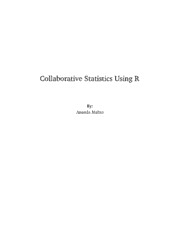Table Of ContentCollaborative Statistics Using R
By:
Ananda Mahto
Collaborative Statistics Using R
By:
Ananda Mahto
Online:
< http://cnx.org/content/col11219/1.7/ >
C O N N E X I O N S
RiceUniversity,Houston,Texas
This selection and arrangement of content as a collection is copyrighted by Ananda Mahto. It is licensed under the
CreativeCommonsAttribution3.0license(http://creativecommons.org/licenses/by/3.0/).
Collectionstructurerevised:January4,2011
PDFgenerated:February6,2011
Forcopyrightandattributioninformationforthemodulescontainedinthiscollection,seep.37.
Table of Contents
Preface ................................................................................................1
1 SamplingandData
1.1 Introduction ................................................................... ..............3
1.2 KeyTerms ..................................................................... ..............3
1.3 Data .........................................................................................5
1.4 Sampling ...................................................................... ..............6
1.5 VariationandCriticalEvaluation .............................................................9
1.6 Frequency,RelativeFrequency,andCumulativeFrequency ..................................12
1.7 Practice .....................................................................................15
Solutions ........................................................................................18
2 DescriptiveStatistics
2.1 Introduction ................................................................................19
2.2 StemandLeafGraphsandBarGraphs ......................................................19
2.3 Histograms .................................................................................24
2.4 BoxPlots ....................................................................................28
Solutions ........................................................................................32
Glossary ..............................................................................................34
Index .................................................................................................36
Attributions ..........................................................................................37
iv
Preface1
About "Collaborative Statistics"
Collaborative Statistics was written by Barbara Illowsky and Susan Dean, faculty members at De Anza
CollegeinCupertino,California.
TheoriginalprefacetothebookaswrittenbyprofessorsIllowskyandDean,nowfollows:
This book is intended for introductory statistics courses being taken by students at two– and four–
yearcollegeswhoaremajoringinfieldsotherthanmathorengineering. Intermediatealgebraistheonly
prerequisite. The book focuses on applications of statistical knowledge rather than the theory behind it.
ThetextisnamedCollaborativeStatisticsbecausestudentslearnbestbydoing. Infact,theylearnbestby
workinginsmallgroups. Theoldsaying“twoheadsarebetterthanone”trulyapplieshere.
Ouremphasisinthistextisonfourmainconcepts:
• thinkingstatistically
• incorporatingtechnology
• workingcollaboratively
• writingthoughtfully
These concepts are integral to our course. Students learn the best by actively participating, not by just
watching and listening. Teaching should be highly interactive. Students need to be thoroughly engaged
in the learning process in order to make sense of statistical concepts. Collaborative Statistics provides
techniquesforstudentstowriteacrossthecurriculum,tocollaboratewiththeirpeers,tothinkstatistically,
andtoincorporatetechnology.
Thisbooktakesstudentsstepbystep.Thetextisinteractive.Therefore,studentscanimmediatelyapply
whattheyread. Oncestudentshavecompletedtheprocessofproblemsolving,theycantackleinteresting
and challenging problems relevant to today’s world. The problems require the students to apply their
newlyfoundskills. Thebookalsocontainslabsthatuserealdataandpracticesthatleadstudentsstepby
stepthroughtheproblemsolvingprocess.
About this custom edition of Collaborative Statistics
ThiscustomeditionofCollaborativeStatisticsisdesignedforuseinashortcourseinintroductorystatistics.
Additionally,thetextincludesexamplesofhowtousetheR-projectopen-sourcestatisticalpackageforthe
calculations.
R software was chosen for several reasons. First, it is free. Second, it is relatively easy to learn once
youactuallystartusingit. Third,thesoftwareisstableandquiteadvanced;therearemanyfeaturesimple-
mentedinRthatarenotfoundincommercialsoftwarepackages. Fourth,Rhasgreatcommunitysupport;
ifthereareanyquestionsyoumighthave,therearenumeroususer-groupswhichcanhelpyousolveyour
problems.
1Thiscontentisavailableonlineat<http://cnx.org/content/m35060/1.1/>.
1
2
Wehopethatyouenjoytheprocessoflearningaboutstatisticsandsimultaneouslylearninghowtouse
R.
Chapter 1
Sampling and Data
1.1 Introduction1
1.1.1StudentLearningObjectives
Bytheendofthischapter,thestudentshouldbeableto:
• Recognizeanddifferentiatebetweenkeyterms.
• Applyvarioustypesofsamplingmethodstodatacollection.
• Createandinterpretfrequencytables.
• BeabletoapplysomebasicfunctionsinRtogeneratesamplesandtosummarizedata.
The R functions you will be using in this chapter are cumsum(), cut(), length(), sample(), set.seed(),
andtable().
1.1.2Introduction
You are probably asking yourself the question, "When and where will I use statistics?". If you read any
newspaperorwatchtelevision,orusetheInternet,youwillseestatisticalinformation. Therearestatistics
about crime, sports, education, politics, and real estate. Typically, when you read a newspaper article or
watch a news program on television, you are given sample information. With this information, you may
makeadecisionaboutthecorrectnessofastatement,claim,or"fact."Statisticalmethodscanhelpyoumake
the"besteducatedguess."
Since you will undoubtedly be given statistical information at some point in your life, you need to
knowsometechniquestoanalyzetheinformationthoughtfully. Thinkaboutbuyingahouseormanaging
abudget. Thinkaboutyourchosenprofession. Thefieldsofeconomics, business, psychology, education,
biology, law, computer science, police science, and early childhood development require at least a basic
understandingofstatistics.
Includedinthischapterarethebasicideasofstatistics. Youwillalsolearnhowdataaregatheredand
what"good"dataare. Additionally, youwillbeintroducedtosomeverybasicfunctionsinRtohelpyou
workmoreefficiently.
1.2 Key Terms2
Instatistics,wegenerallywanttostudyapopulation. Youcanthinkofapopulationasanentirecollection
ofpersons,things,orobjectsunderstudy. Tostudythelargerpopulation,weselectasample. Theideaof
1Thiscontentisavailableonlineat<http://cnx.org/content/m35069/1.2/>.
2Thiscontentisavailableonlineat<http://cnx.org/content/m35062/1.1/>.
3
4 CHAPTER1. SAMPLINGANDDATA
samplingistoselectaportion(orsubset)ofthelargerpopulationandstudythatportion(thesample)to
gaininformationaboutthepopulation. Dataaretheresultofsamplingfromapopulation.
Because it takes a lot of time and money to examine an entire population, sampling is a very practi-
cal technique. If you wished to compute the overall grade point average at your school, it would make
sensetoselectasampleofstudentswhoattendtheschool. Thedatacollectedfromthesamplewouldbe
thestudents’gradepointaverages. Inpresidentialelections,opinionpollsamplesof1,000to2,000people
are taken. The opinion poll is supposed to represent the views of the people in the entire country. Man-
ufacturersofcannedcarbonateddrinkstakesamplestodetermineifa16ouncecancontains16ouncesof
carbonateddrink.
From the sample data, we can calculate a statistic. A statistic is a number that is a property of the
sample. For example, if we consider one math class to be a sample of the population of all math classes,
then the average number of points earned by students in that one math class at the end of the term is an
exampleofastatistic. Thestatisticisanestimateofapopulationparameter. Aparameterisanumberthat
isapropertyofthepopulation. Sinceweconsideredallmathclassestobethepopulation,thentheaverage
numberofpointsearnedperstudentoverallthemathclassesisanexampleofaparameter.
One of the main concerns in the field of statistics is how accurately a statistic estimates a parameter.
Theaccuracyreallydependsonhowwellthesamplerepresentsthepopulation. Thesamplemustcontain
thecharacteristicsofthepopulationinordertobearepresentativesample. Weareinterestedinboththe
sample statistic and the population parameter in inferential statistics. In a later chapter, we will use the
samplestatistictotestthevalidityoftheestablishedpopulationparameter.
A variable, notated by capital letters like X and Y, is a characteristic of interest for each person or
thing in a population. Variables may be numerical or categorical. Numerical variables take on values
with equal units such as weight in pounds and time in hours. Categorical variables place the person or
thing into a category. If we let X equal the number of points earned by one math student at the end of a
term,thenX isanumericalvariable. IfweletYbeaperson’spartyaffiliation,thenexamplesofYinclude
Republican,Democrat,andIndependent. Y isacategoricalvariable. Wecoulddosomemathwithvalues
of X (calculatetheaveragenumberofpointsearned,forexample),butitmakesnosensetodomathwith
valuesofY(calculatinganaveragepartyaffiliationmakesnosense).
Data are the actual values of the variable. They may be numbers or they may be words. Datum is a
singlevalue.
Twowordsthatcomeupofteninstatisticsareaverageandproportion. Ifyouweretotakethreeexams
inyourmathclassesandobtainedscoresof86,75,and92,youcalculateyouraveragescorebyaddingthe
threeexamscoresanddividingbythree(youraveragescorewouldbe84.3toonedecimalplace).If,inyour
mathclass, thereare40studentsand22aremenand18arewomen, thentheproportionofmenstudents
is 22 andtheproportionofwomenstudentsis 18. Averageandproportionarediscussedinmoredetailin
40 40
laterchapters.
Example1.1
Definethekeytermsfromthefollowingstudy: Wewanttoknowtheaverageamountofmoney
firstyearcollegestudentsspendatABCCollegeonschoolsuppliesthatdonotincludebooks. We
randomlysurvey100firstyearstudentsatthecollege. Threeofthosestudentsspent$150, $200,
and$225,respectively.
Solution
ThepopulationisallfirstyearstudentsattendingABCCollegethisterm.
ThesamplecouldbeallstudentsenrolledinonesectionofabeginningstatisticscourseatABC
College(althoughthissamplemaynotrepresenttheentirepopulation).
The parameter is the average amount of money spent (excluding books) by first year college
studentsatABCCollegethisterm.
The statistic is the average amount of money spent (excluding books) by first year college
studentsinthesample.
Thevariablecouldbetheamountofmoneyspent(excludingbooks)byonefirstyearstudent.

